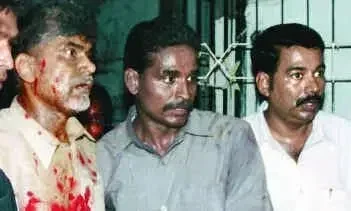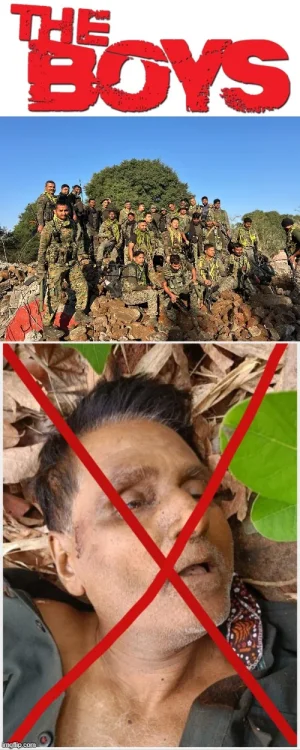Karregutta hills are under the direct watch of the shenanigans sitting on Raisina Hills. Based on reports, the hills have been surrounded by thousands of security forces.
Karregutta hills along Chhattisgarh-Telengana border. Photo: Special arrangement (via Ranu Tiwari)
PlayNext
Mute
Current Time 0:00
/
Duration 2:04
Loaded: 25.74%
Fullscreen
Today is the eleventh day. Like a fort besieged by the enemy in a medieval war, a thousand-strong rebel army is said to have dug into the hills deep inside central India. The hills are known by the name of Karregutta, unheard and unknown so far. We also hear of the army’s commander, Madvi Hidma.
Hidma is already a legendary name among many Adivasis in the area, the stuff of many make-believe stories. The besieging army are the security forces, drones and military helicopters of the modern Indian democratic state. Now we hear that they have discovered a tunnel inside a cave underneath the hill, complete with a
shivling and a water source. Did the rebels hide here?
As we can see, a completely mythical scene is unfolding in front of us today, yet all very real. It is more real than we can handle – more real than the simulated reality of our life inside the proverbial Matrix. The mythical, as Furio Jesi was fond of saying, allows the extra-temporal to disrupt historical time and expand our horizons.
So let us pause for a minute in order to immerse in this moment and savour the broadening of our imagination. And we start in an unlikely place: a government website.
If you go to the website of the Modi government’s
Azadi ka Amrit Mahotsav, there is
a section on “parallel governments”. We are told about the great experiment of the parallel, or rebel, government (
prati sarkar) that was formed in Satara in Maharashtra during 1943-46. Then we are told of the Tamluk National Government formed in Midnapore district of Bengal on December 17, 1942. We are also told of other such parallel governments that were formed in the run-up to the Independence of India.
Also read:
Why Indian Democracy Feels No Shame About the Bastar Killings
There is high praise for these experiments of democracy and true empowerment of the masses. However, going beyond such homilies of praise, we have to ask: what do these parallel governments mean in terms of their political significance?
The answer is not too far to find: they allow us to put the Indian republic we inherited into perspective; they allow us to see that this Republic was one among many other possibilities. That it was only because of other circumstantial factors that favoured the Republic which finally came into being, which is what we have today, that it became a
fait accompli.
Gail Omvedt is among few scholars who engaged with this question. I had earlier pointed out how
the Indian Constitution displaced radical possibilities and narrowed our political imaginary.
What is clear is that this Republic came into being by displacing several other concrete possibilities. Satara and Tamluk are just the names we have today for these possibilities. There could have been many others, not only in terms of parallel governments and practical experiments, but also in vision and political imaginaries that were never actualised in practice.
For that matter, Bhagat Singh’s vision too would have led to a different kind of a Republic.
But somehow, after its founding, the present Indian Republic spawned a narrative which retroactively annulled the other possibilities whose erasure marked its birth. The centralising tendency of the Indian state must be understood in this light. Soon enough, the Telangana peasant uprising would be mercilessly crushed by Nehru in 1950-51 to coincide with the adoption of the constitution and the vision for a “new democratic India”.
Thus, the vision for a new Republic in India, if you like, the Second Indian Republic, could make an appearance only in a mythic form, as something fantastic and so out of joint with “reality”, as though from another world. We then have names like Karregutta and Hidma, hitting us all with such freshness and vigour.
What is happening in Karregutta?
An aerial view of the area surrounding Karregutta hills along Chhattisgarh-Telengana border. Photo: Special arrangement (via Ranu Tiwari)
Karregutta hills is located somewhere along the boundaries between Chhattisgarh and Telangana. Hidma, by all accounts, seems to be the
de facto head of the
Janatana Sarkar (people’s government), a parallel government existing in the area. They make small dams, try new agricultural practices, new human relations and culture. This involves the imagination and practice of a new political system.
However, for us today, the present imposes itself with brute force. Thus Karregutta hills are under the direct watch of the shenanigans sitting on Raisina Hills. Based on reports that are sometimes conflicting, we know that these hills are surrounded by thousands of security forces: CRPF, Greyhounds, C-60 commandos, DRG, Bastar fighters with backup by Indian Air Force helicopters, drone surveillance and so on.
So, God forbid, the hills might be waiting to be the Indian Republic’s very own Jallianwala Bagh, as security forces seem all set to move in and massacre.
But we must not already rein in the possibilities offered by the mythic even in the face of state terror. For there is, however, another reference to the Karregutta hills – the hills of Dombari Buru in Jharkhand.
What are the Dombari hills? That is precisely where Birsa Munda died fighting in June 1900. Today, we are forced to ask the question: do we have a figure like Birsa Munda among us today?
Bhumkaal
Every year, Bastar comes alive with massive events and celebrations commemorating the
Bhumkaal which took place in 1910. A
Wikipedia search will tell you that the
Bhumkaal was a fierce Adivasi rebellion against the British Raj in Bastar. This is true but we must also add that
Bhumkaal is the time of the earth — the time of the Adivasi.
The Adivasi did not just fight outsiders, but also fought to be close to the earth, fought for life close to the earth.
Hidma upholds the
Bhumkaal which was led by, as adivasis will tell you, the rebel leader Gundadhur. Every government and politician in Chhattisgarh wants to be seen as upholding the great legacy of Gundadhur.
Also read:
In Chhattisgarh, Zero Tolerance for Democracy
Gundadhur died fighting, much like Birsa Munda. Legend has it that the great warrior never really died, but always comes back and in fact lives to inspire adivasis to keep fighting. There are great stories of his tact and magic feat to deceive and mislead the enemy.
In the broad scale of history, we must tell those in the state today who are obsessed with Indian civilisation and Indic traditions, that they are involved in repeating the worst tropes of civilisational genocide, viz., killing the
asuras.
If they are so brazen about being such killers, then at least have the galls to believe in the theory of the Aryan invasion. A coloniser who kills is perhaps more tolerable than an insider who kills their own people. But that is precisely what is taking place in the Adivasi areas, where the state is at war with its own people.
For Modi to kill Hidma today is no different than Indra who killed the
Asura king
Vritra through guile and deceit. We know what then happened to Indra, as told in an orthodox literature like the
Mahabharata:
Now when the mighty Vritra, terrible to the gods, was killed, Indra became overpowered by falsehood, and he became exceedingly sad…, overpowered by his own sins, he could not be recognised. And he lay concealed in water, just like a writhing snake… (
Udyoga Parva).
Modi also reminds us of the treachery of Lord Vishnu in the
vamana avatar. As the Indian state and its mighty machinery are now shamelessly threatening to massacre a ragtag rebel army of Adivasis, we are reminded of Lord Vishnu’s
virat roop (immense form). And we know that this
virat form was really about seizing all property and resources from King Bali, the king of the asuras, and exile him to the
paatal lok, the netherworld. Hidma appears like the asura King Bali who never died, and who lives on, even as the Gods,
devas, were bent upon denying “immortality” to the
asuras.
Radicals must also keep in mind that declaring atheism against the sky gods (like Indra) will not suffice, as the earthly deities must first sort out their battles with them.
Hidma on Karregutta Hills then completely spills the beans of Indian civilisation as also of the Indian Republic and all their lies. One is also reminded of the untouchable warriors of the 1818 Battle of Koregaon, who, as I pointed out earlier, could mobilise
the “powers of the other shore”.
So, what is happening?
Today we are on the eleventh day of the stalemate of the siege. The security forces have still not dared to move in. Nor do we have much indication of what exactly is going on inside the ranks of the rebels. We also do not have any fresh statements from Hidma.
Maybe some of the rebels have already found their way out of Karregutta, giving the immense security build-up a marvellous slip; or maybe they are contemplating “giving up”, finding safe haven in Telangana or elsewhere. In any case, the Indian state hates this stalemate. It was hoping to just “bump off” (in “encounter”) these rebels and move on, so that there will never be space for a conversation about their vision.
The stories of encounter killings, false or real, kept the conversation within the narrow confines of judicial versus extra-judicial, what is lawful and what is unlawful, the constitutional and the unconstitutional. Now, the state’s extra-judicial action is deferred and in the deferral there might be other pathways towards new outcomes. It is time for the world to not just ask for news reports of “what is going on” and so on, but to step into the space opened up by the deferral and the gap.
The Hidma strategy might be already working as the “gap” and the deadlock at Karregutta inspires fantastic visions of excess and mythic epiphanies. A mythic disjunction in the present helps us break with our fundamental and unconscious attachments to the system – including with the existing Republic.
Saroj Giri teaches Politics in University of Delhi and is part of the Forum Against Corporatisation and Militarisation (FACAM).

thewire.in







